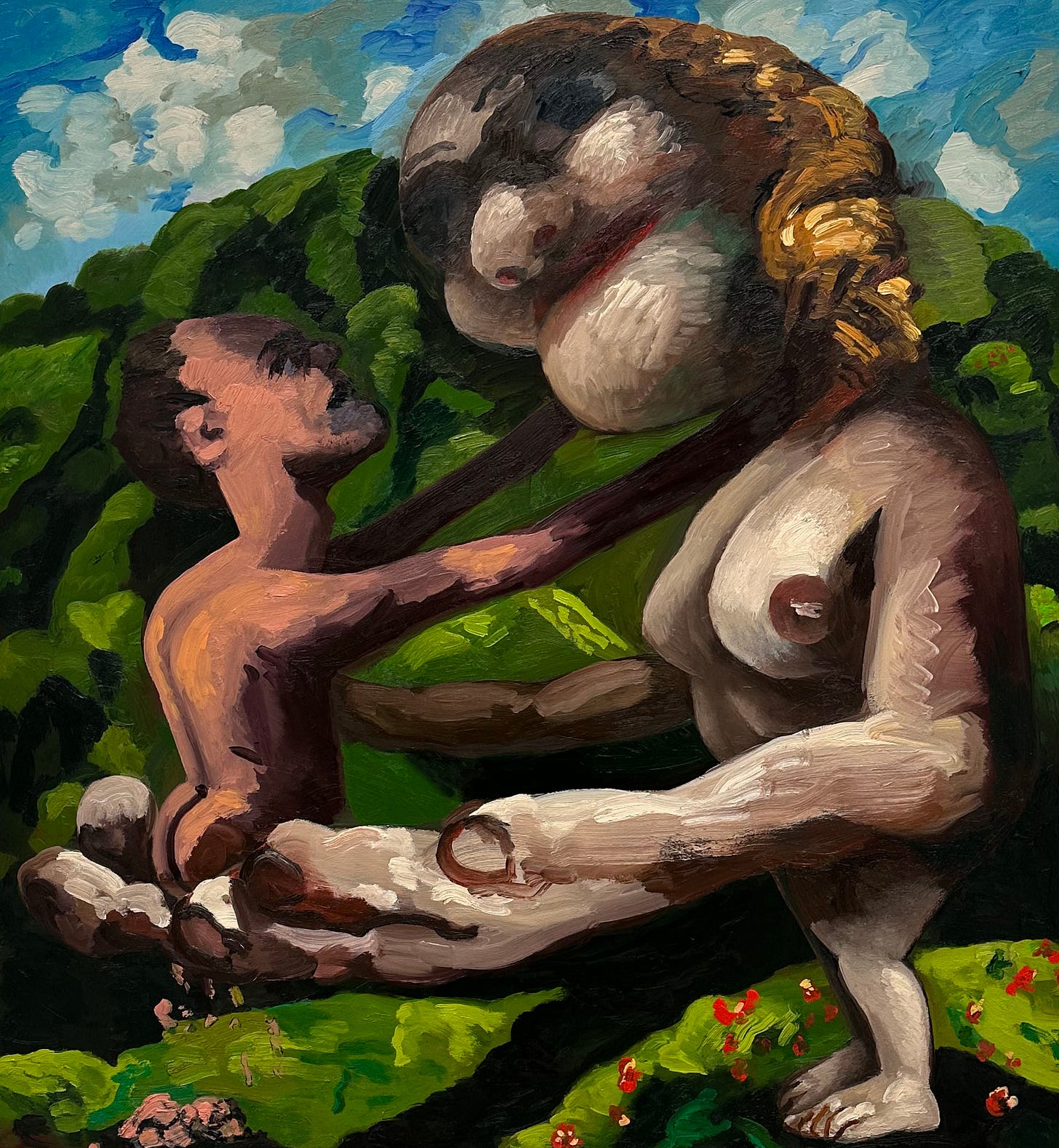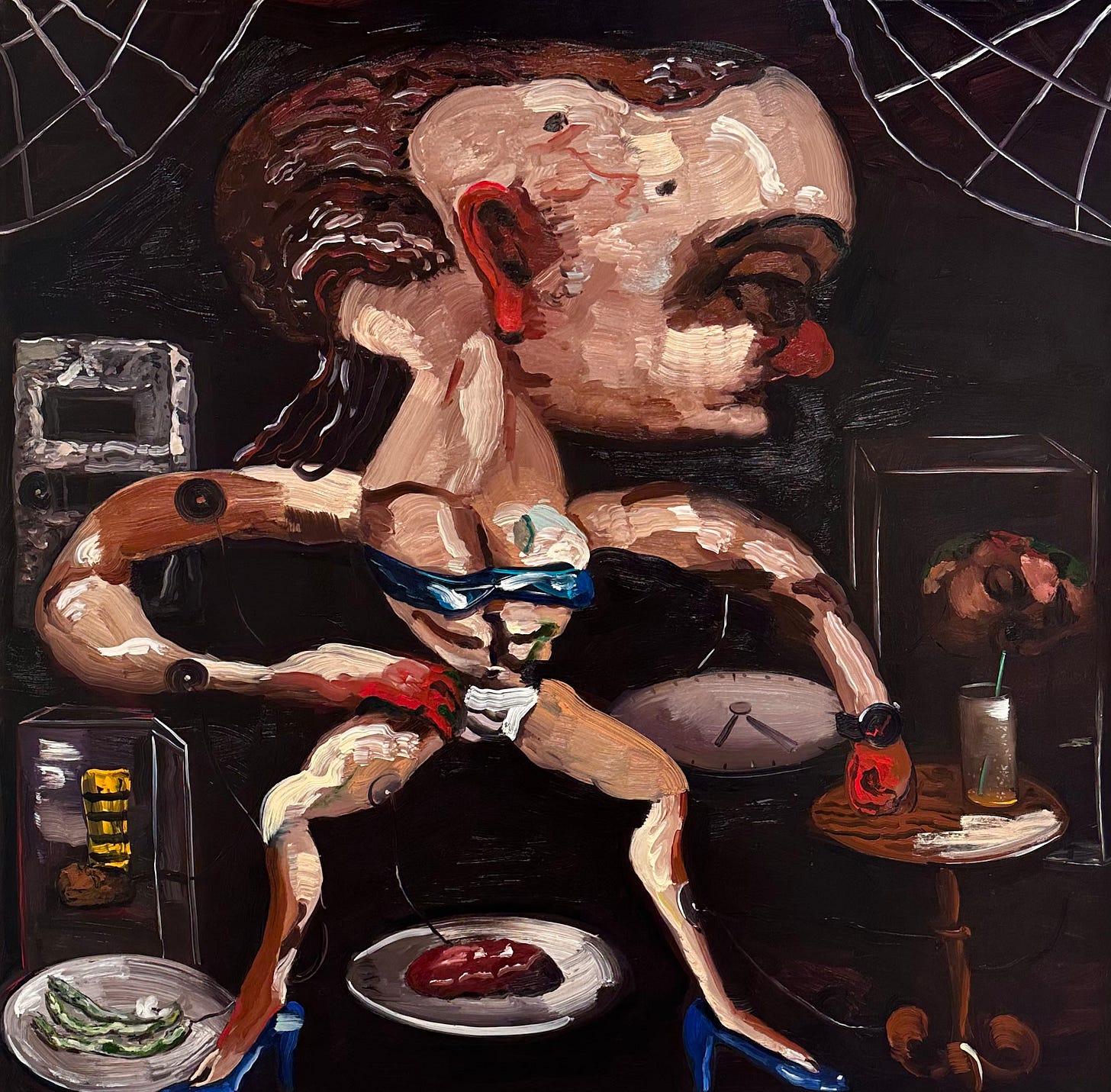November 21st (in)composition
my fall orange glow, dana schutz, and barton's auction highlights
what to eat: persimmons
To know me is to know that I am a persimmon junky. On my ultimate list of top fruits, persimmons are queen. Every year, I eagerly count down the days to when these plump, vibrant, orange fruits make their way to the nearest market. In peak season, I can barely go a day without eating at least one persimmon. I hoard them throughout fall and early winter, eating them in abundance until I turn orange.
At the height of persimmon season, you will undoubtedly catch me “orange-handed” walking around the streets of NYC with a half-bitten persimmon in hand or with a tote delicately filled to the brim with these precious jewels.
If you stop by my home, you will likely leave with a semi-ripe persimmon along with strongly-worded plea to be patient and resist indulging until its reached its pinnacle of ripeness.
When the season comes to an end, my heart aches, and I find myself back where I started, counting down the days all over again until I can eat my weight in my favorite fruit.


The two varieties of persimmons we commonly find in NYC are Fuyu and Hachiya. Hachiya are also known kaki/cachi should you find yourself in Asia or in some European countries. I have had the pleasure of finding kaki throughout Italy and France over my fall travels.

I love both varieties, though they have different characteristics.
Fuyus look like flat, firm, glossy orange tomatoes that are most delicious when they are eaten right off the stem. They should have shiny, bright skin and feel firm to the touch. Look for top leaves that are more green than brown, which indicates freshness. When biting into one, they should be succulent but still maintain a nice, crunchy texture. If they are unripe they will be too hard and will not taste as sweet. They are best stored at room temperature and eaten immediately, but you can store them in the fridge for a couple of days. I like to enjoy them raw and generally have one in my tote as they are easier to consume when walking around vs. the hachiya persimmon. Other fun ways to consume fuyus: toss them into your fall and winter salads or sub them in for tomatoes and make a salsa or a caprese.

As much as I adore a fuyu, I idolize the hachiya aka kaki persimmon. Hachiyas are larger globe-like fruits that are oval/curved with a thinner skin.
The main difference between hachiyas and fuyus is that when hachiyas are perfectly ripe, they have the opposite texture. A ripe hachiya looks as if they are about to burst. The fruit swells and the color evolves from a pale orange to the most vibrant, neon red-orange. They are very delicate to handle - think of a thin water balloon that’s about to pop, and treat them as such. The ripe fruits are gooey and luscious with sweet, subtle nuances of cinnamon and honey.
Never bite into an unripe hachiya. They are unpleasant and astringent. They’ll leave you puckering with a cotton-mouth sensation. You will know if they are unripe if they are firm and do not yet have their neon glow. Again, trust me when I say, be patient. Wait diligently to the point where the fruit look as if it is about to fall apart before consuming. They are worth it.

Throughout the season there are clusters of hachiya persimmons in different spots of my kitchen, depending where they are in their ripening process. I like hiding very firm pieces in depths of my dark pantry to speed up the process, or high up on the top of cabinets when they are half-baked. You can tell if they are ripening if they start to soften and change color. When they are a couple of days away from their peak ripeness, I like to proudly display them, leaf side down, on a regal tazza (sourced ofc from LiveAuctioneers) on the counter top to keep an eye on them from going over. Do not put them in the fridge in the middle of the ripening as this will stop the process altogether. You can store them in the fridge when ripe, although mine never make it to fridge (because I inhale them).
Since the fruit at it’s ripest is gooey mess, the easiest method for most people to eat one is to place it in a bowl, stem side down and make a little hole at the top, eating it with a spoon. I personally never mind a messy treat, especially when it comes to my hachiyas. I usually bite the end of the persimmon and suck all the gooey goodness through my incisions, leaving the skin intact .
They are the perfect fruit perfect for making any compotes, jams or jellies. You can freeze an extra gooey hachiya to enjoy as an excellent sorbet. Their cinnamon essence pairs well with chocolate and fun holiday spices such as nutmeg, cloves etc. You can use them as an alternative to pumpkin and make a persimmon pie, or southern persimmon pudding, or even make a persimmon bread.
what to see: dana schutz “jupiter's lottery” at david zwirner
“Dana Schutz is an unbridled legend, whose ultra-vivid, tragicomic paintings command attention like few others of her generation. Schutz paints wet-on-wet, populating her scenes with a semi-grotesque, evocative cast of characters.”1 I am absolutely obsessed with the tactile, otherworldly, sculptures on view alongside her monumental paintings.
design crush of the week: barton’s auction
Every season, I am on the edge of my seat waiting for to Barton’s Auction to release their quarterly sale (which ironically might include a new seat). Based in Nazareth, PA, this meticulously curated auction house delivers right to NYC for a small fee (depending on the size of your lot). You can take at the full upcoming sale here. Below are some of my fav’s:
https://www.culturedmag.com/article/2023/11/17/karyn-lyons-diana-al-hadid-dana-schutz

























Yum yum YUM 🤤 need persimmons immediately